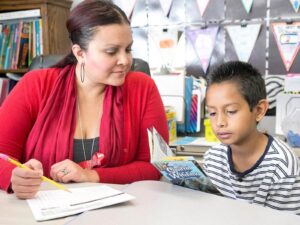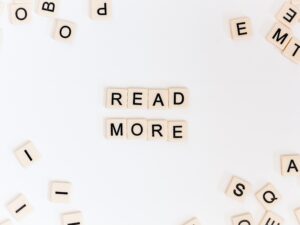When & How Much to Use Digital Resources
By Michaela Khani | Teacher & Advisor to Educational Consultants

Introduction
Digital literacy resources can certainly simplify providing work for students. Digitals can keep students on task and learning at their specific level with minimal hassle.
However, the last thing that we want to do is overplay an approach – causing unnecessary issues down the track. So, it begs the questions, are there circumstances that digitals are inappropriate?
It turns out there are…
Balancing our young people’s screen time is a constant battle, but when used in the right way and at the right level of learning, digital resources can be a helpful alternative to developing literacy skills. At this stage, you may be wondering, well, which of my students might benefit from practising reading digitally? We will give you a hint – it’s likely to be just over half of your class…*
Executive Summary
If you only have time for a quick coffee break – here it is in a nutshell;
If you have students who are reading at the level you would expect them to, then digital resources such as eBooks can be a great way to continue their literacy development in our, increasingly, online learning environment.
However, for students that struggle with reading and are behind in literacy development, physical books with interesting and related activities and if you have them available to you – audio assisted books.
If you are also after the reasons why, please allow me to first briefly share an experience close to home before getting into the research.
Personal Story
Recently, my nephew’s term-report indicated that he was behind in literacy. Coming from a family of teachers, we were a bit shocked and concerned. Here is the extra-curricular learning we engaged to get him back on track…
Firstly, we needed to figure out what the actual problem was. We emailed his teacher. When there was no response, we simply asked my nephew. He told us that during lockdown, the school moved to using a more digital approach to learning. This has continued when at school as well.
Next, we engaged a structured whole-reading approach for maximum improvement. We hit him with levelled, high interest physical books supported with title-specific activities. Interestingly, his sister (younger but advanced for her age) also got inspired and did some extra work alongside him. This seemed to encourage more learning.
The result: by the end of the next term he is now ahead in his literacy and back to doing mainly online learning – success!
The Research
The above story is only a single example, but you may be wondering, why did this work so well? Was it a fluke? Did we just need to pay that little bit more attention? It turns out both the issue and solution is being experienced universally around the world. Let’s see what the research has to say…
The main part of the solution, and a phrase you may have picked up on earlier is ‘structured approach’ and if you’re keen on a bit more light reading, you can click on this link to read our article that focusses on this specifically here.
A big take away from that article is that 40% of students need a structured approach. In contrast, “research shows that 60 per cent of learners (hence, ‘just over half’*) will succeed whatever the method. In essence, they just need a reasonable amount of exposure to text.” – Lugg,. 2017.
You may have also noticed that we also applied an ‘unplugged’ approach — we used physical books. We later found out that his teacher had also removed him from digitals during this time – credit to her!
One leader in the field is neuroscientist, Dr Maryanne Wolf with an impressive resume: Ed.D, Scholar, Teacher, Advocate for children and literacy around the world, Director of the Center for Reading and Language Research at Tufts University.
Some of Dr Wolf’s amazing insights include these quotes:
• “Research is surfacing in many parts of the world suggesting that those who read on digital devices don’t comprehend as well, don’t sequence details well and don’t recall the plot as well as those reading the same material in print.”
• “Reading more on screens may threaten the young brain’s ability to build its own foundation of knowledge and the desire to think and imagine for themselves.”
• “More and more young people not reading other than what is required, and often not even that.”
Of course comprehension and depth of learning can still be encouraged when using digitals – through providing ample supporting activities and questions. There are also many researched benefits of using digitals. To summarise, here are some pros and cons for both approaches to reading improvement:
Digital Reading:
Positives:
- Increases the amount of reading due to the growth of online material
- Improved speed of reading
- Improved skimming ability
- Sometimes more engaging
- Often easier and faster to provide more books, classroom-wide
- Usually more cost-effective
Negatives:
- Patience of readers reduces
- Multitasking (less concentration)
- Distractions
- Eye strain
- Scanning rather than reading through
- Less in-depth and critical reading and thus, more open to ‘fake news’
Print Reading
Positives:
- More thorough reading (from beginning to end)
- Better for concentration
- Better comprehension
- More enjoyable
- Easier to navigate (to support learning)
Negatives:
- Can be seen as “not as cool”
- Can be seen as more difficult
As you can see, there are many pros and cons for both. As Alcott (2019) describes, “it’s not an either/or choice but a matter of how we get the best out of both. Wolf suggests that we need to teach our students which medium best suits the purpose for which we are reading. Her best hope for our reading future is the ‘bi-literate’ brain — one that uses the optimal skills of each reading style so that students can read deeply as well online as in print.”
Summary
In conclusion, research is clear in finding much more enjoyment and deeper learning comes from reading physical books wherever possible, as much as possible. While this is particularly important for students who aren’t reading at their age-level, at least mixing up digital/physical books for all students is highly recommended by educational professionals.
As a teacher I know, if I can keep the majority of my class on task in a simple, effective way using digitals, I can spend more time focusing on the below-level students.
Recommended Resource
Interested in getting started with Digital Resources for successful online learning? Click here
 RAINBOW READING & TOXIC DIGITAL SERIES
RAINBOW READING & TOXIC DIGITAL SERIES
• Levelled books with age-appropriate topics and pictures
• Audio-assistance (accelerates reading improvement by an average of 400%)
• Supporting activities to increase comprehension
• Title-specific questions to increase depth of learning
• Teacher and student instructions for easy set up
References
Is Digital Reading Changing How Our Brains Work? -2018
Reading Digital World Affects Your Brain Development
Dr Maryanne Wolf
Reading On-screen vs Reading in Print: What’s the Difference for Learning? -2019
Lisa Allcott
The Impact of the Internet on Reading Behaviour -2014
Val Hooper and Channa Herat
The Impact of ebooks on the Reading Motivation and Reading Skills of Children and Young People -2015
National Literacy Trust
Books or e-books: which are best for your child?
The School Run
Do Students Lose Depth in Digital Reading? -2017
Naomi Baron
New Zealand’s Falling Literacy Rates are Due to Poor Teacher Training -2017
Ros Lugg



